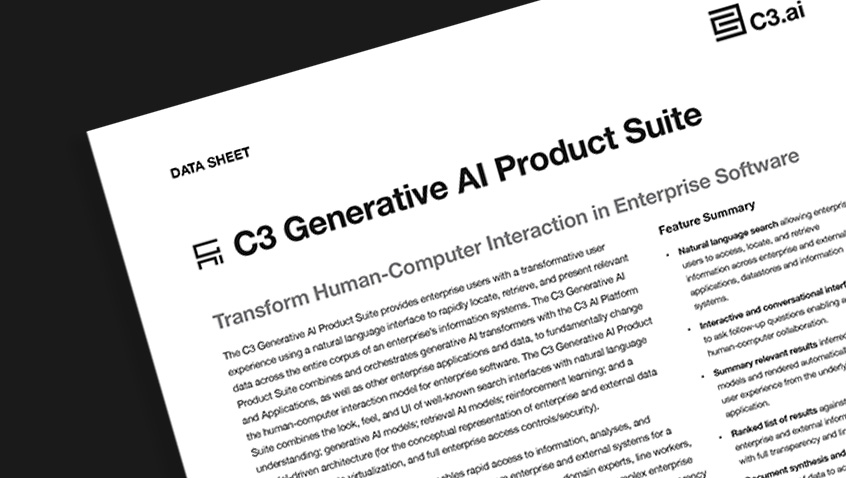- AI Software
- C3 AI Applications
- C3 AI Applications Overview
- C3 AI Anti-Money Laundering
- C3 AI Cash Management
- C3 AI CRM
- C3 AI Decision Advantage
- C3 AI Demand Forecasting
- C3 AI Energy Management
- C3 AI ESG
- C3 AI Intelligence Analysis
- C3 AI Inventory Optimization
- C3 AI Process Optimization
- C3 AI Production Schedule Optimization
- C3 AI Property Appraisal
- C3 AI Readiness
- C3 AI Reliability
- C3 AI Smart Lending
- C3 AI Sourcing Optimization
- C3 AI Supply Network Risk
- C3 AI Turnaround Optimization
- C3 AI Platform
- C3 Generative AI
- Get Started with a C3 AI Pilot
- Industries
- Customers
- Resources
- Generative AI
- Generative AI for Business
- C3 Generative AI: How Is It Unique?
- Reimagining the Enterprise with AI
- What To Consider When Using Generative AI
- Why Generative AI Is ‘Like the Internet Circa 1996’
- Can Generative AI’s Hallucination Problem be Overcome?
- Transforming Healthcare Operations with Generative AI
- Data Avalanche to Strategic Advantage: Generative AI in Supply Chains
- Supply Chains for a Dangerous World: ‘Flexible, Resilient, Powered by AI’
- LLMs Pose Major Security Risks, Serving As ‘Attack Vectors’
- C3 Generative AI: Getting the Most Out of Enterprise Data
- The Key to Generative AI Adoption: ‘Trusted, Reliable, Safe Answers’
- Generative AI in Healthcare: The Opportunity for Medical Device Manufacturers
- Generative AI in Healthcare: The End of Administrative Burdens for Workers
- Generative AI for the Department of Defense: The Power of Instant Insights
- What is Enterprise AI?
- Machine Learning
- Introduction
- What is Machine Learning?
- Tuning a Machine Learning Model
- Evaluating Model Performance
- Runtimes and Compute Requirements
- Selecting the Right AI/ML Problems
- Best Practices in Prototyping
- Best Practices in Ongoing Operations
- Building a Strong Team
- About the Author
- References
- Download eBook
- All Resources
- C3 AI Live
- Publications
- Customer Viewpoints
- Blog
- Glossary
- Developer Portal
- Generative AI
- News
- Company
- Contact Us
- Generative AI for Business
- C3 Generative AI: How Is It Unique?
- Reimagining the Enterprise with AI
- What To Consider When Using Generative AI
- Why Generative AI Is ‘Like the Internet Circa 1996’
- Can Generative AI’s Hallucination Problem be Overcome?
- Transforming Healthcare Operations with Generative AI
- Data Avalanche to Strategic Advantage: Generative AI in Supply Chains
- Supply Chains for a Dangerous World: ‘Flexible, Resilient, Powered by AI’
- LLMs Pose Major Security Risks, Serving As ‘Attack Vectors’
- C3 Generative AI: Getting the Most Out of Enterprise Data
- The Key to Generative AI Adoption: ‘Trusted, Reliable, Safe Answers’
- Generative AI in Healthcare: The Opportunity for Medical Device Manufacturers
- Generative AI in Healthcare: The End of Administrative Burdens for Workers
- Generative AI for the Department of Defense: The Power of Instant Insights
Generative AI and the Future of Business

Key Considerations for Adopting Generative AI in the Enterprise
Organizations looking to adopt generative AI technologies for enterprise use cases stand to gain a major productivity boost. Yet as with many leading-edge technologies, several factors exist that business leaders should consider when choosing a generative AI technology partner.
Data Availability and Quality
Generative AI domain models require large amounts of data to be trained effectively. Difficulty in obtaining or collecting relevant data, particularly for specialized or rare situations can limit the scope and effectiveness of the model. Furthermore, limited availability of high-quality data can lead to poor performance and accuracy of the model. Consequently, enterprises should consider both the availability and quality of data to train and operate generative AI systems.
Security and Privacy Risks
In addition to availability and quality of data, unauthorized use of sensitive data for training or operating the model can also expose the enterprise to security and privacy risks. Vulnerabilities in the model architecture could be exploited by hackers to gain access to sensitive data and cause harm to individuals and enterprises. Moreover, lack of transparency and accountability in data handling and use could lead to potential regulatory noncompliance.
Intellectual Property Risks
With public-facing generative AI systems, enterprises may be exposed to intellectual property infringement risks. By design, public generative AI systems are trained on internet data. Consequently, generated content similar to existing works that are protected by intellectual property laws could lead to legal actions and potential financial damages. Ongoing debate around the ownership and authorship of generated content from public generative AI systems could lead to legal disputes and challenges.
Bias and Inaccuracy
As the generative AI model is trained on available data, bias and inaccuracy in the training data can be perpetuated or even amplified in the output of the model, leading to discriminatory, legally risky, or unsafe outcomes. Furthermore, inaccurate answers due to outdated or irrelevant data or model hallucination can lead to unintended consequences and exacerbate an existing issue.
Domain Models
With a customized generative AI model trained on the enterprise’s own data and deployed on top of enterprise data and applications, enterprises can reap the benefits of generative AI systems while minimizing risks.
First, many enterprises likely have a wealth of high-quality data that is subject to rigorous data management practices and quality checks. Secondly, enterprise data is often subject to access controls and security measures, which can help prevent unauthorized access to sensitive data. Moreover, as enterprise data is typically owned by the organization, generating content based on enterprise’s own data eliminates intellectual property rights risks. Diverse, representative, and high-quality enterprise data can also help minimize bias in model outputs. Finally, while limiting hallucinations is an ongoing research area, generative AI systems that have a built-in feedback loop with human evaluation, such as the C3 Generative AI Product Suite, will be able to eliminate hallucination and inaccuracy over time.



